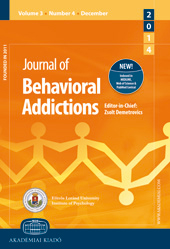Problem gambling and family violence: Findings from a population-representative study
Problem gambling and family violence: Findings from a population-representative study
Author(s): Nicki A. Dowling, Carrie Ewin, George J. Youssef, Stephanie S. MerkourisSubject(s): Behaviorism
Published by: Akadémiai Kiadó
Keywords: problem gambling; intimate partner violence; family violence; victimization; perpetration; psychological distress
Summary/Abstract: Few studies have investigated the association between problem gambling (PG) and violence extending into the family beyond intimate partners. This study aimed to explore the association between PG and family violence (FV) in a population-representative sample. It was hypothesized that: (a) PG would be positively associated with FV, even after adjusting for sociodemographic variables and comorbidities and (b) these relationships would be significantly exacerbated by substance use and psychological distress. A secondary aim was to explore whether gender moderated these relationships. Methods. Computer-assisted telephone interviews were conducted with a population-representative sample of 4,153 Australian adults. Results. Moderate-risk (MR)/problem gamblers had a 2.73-fold increase in the odds of experiencing FV victimization (21.3%; 95% CI: 13.1–29.4) relative to non-problem gamblers (9.4%; 95% CI: 8.5–10.4). They also had a 2.56-fold increase in the odds of experiencing FV perpetration (19.7%; 95% CI: 11.8–27.7) relative to non-problem gamblers (9.0%; 95% CI: 8.0–10.0). Low-risk gamblers also had over a twofold increase in the odds of experiencing FV victimization (20.0%; 95% CI: 14.0–26.0) and perpetration (19.3%; 95% CI: 13.5–25.1). These relationships remained robust for low-risk gamblers, but were attenuated for MR/problem gamblers, after adjustment for substance use and psychological distress. MR/problem gamblers had a greater probability of FV victimization, if they reported hazardous alcohol use; and low-risk gamblers had a greater probability of FV perpetration if they were female. Discussion and conclusion. These findings provide further support for routine screening, highlight the need for prevention and intervention programs, and suggest that reducing alcohol use may be important in these efforts.
Journal: Journal of Behavioral Addictions
- Issue Year: 7/2018
- Issue No: 3
- Page Range: 806-813
- Page Count: 8
- Language: English

